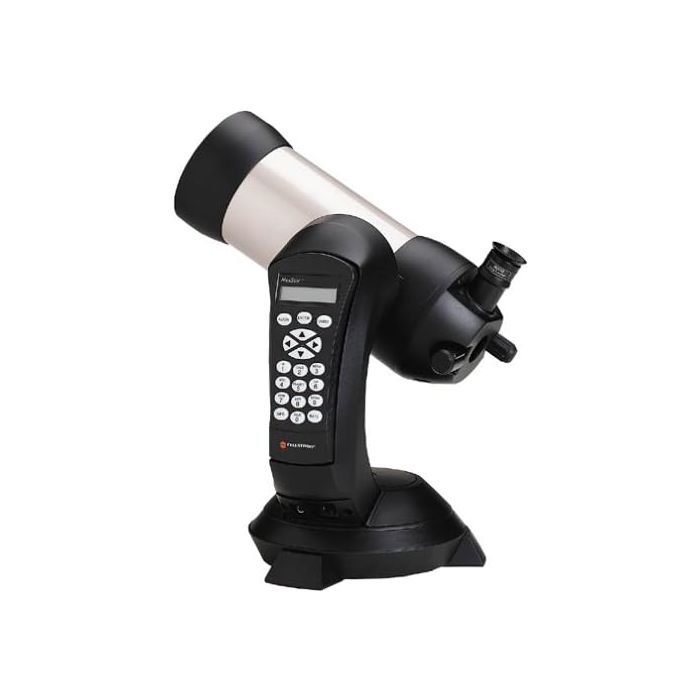This is a demo store. No orders will be fulfilled.
Celestron Nexstar 4GT 4" Computerized Go-To Telescope (Telescope Only)
Amazon.com
Amazon.com Review The computerized Celestron NexStar 4GT joins a 4-inch f/13 Maksutovtube assembly to the same "goto" mounting used with Celestron's other small NexStar telescopes (such as the
NexStar 80GT refractor
and
NexStar 114GT Newtonian reflector
). Introduced in late 2001, the NexStar 4GT is intended to go head-to-head with Meade Instruments' successful ETX series of small Maksutov telescopes. It comes with 25-mm (53x) and 10-mm (113x) SMA eyepieces, a hand controller, and a StarPointer red-dot finder (which I find far more useful than the tiny finderscope that comes with the
Meade ETX90EC
.
See a detailed view of the NexStar 4GT's features
Like the Meade, the NexStar 4GT is designed to take the guesswork out of finding sky objects. Setup is very easy. Take the telescope out of the box, install 8 AA-size batteries, plug in the hand controller, attach the StarPointer, and the telescope is ready to use. The one-armed mounting, which is permanently attached to the telescope, can be placed on a flat surface, any sturdy photographic tripod, or
Celestron's own tripod/wedge combination
.
Once the telescope's computer has been initialized to the sky, any of over 4,000 targets can be selected from the onboard database by using the hand controller. Choose each target by scrolling through menus while reading object names and information from the controller's LCD readout. Large, softly backlit control buttons are easy to see and press, even when wearing gloves on cold nights, although I have found that the brightness of the LCD readout tends to drop off as the temperature approaches freezing.
In practice, the NexStar 4GT's goto system works adequately provided it was properly initialized and has a fresh set of batteries. Although the motors are noisy when slewing from object to object, the selected target is usually within the field of the 25-mm eyepiece. Once in a while, however, the telescope will go into a "death slew," seemingly spinning around aimlessly. To bring the scope back to its senses, press one of the direction keys, then "Enter" to try again. Sometimes, this will happen when the batteries are running out of power, for which the NexStar 4GT has quite an appetite. A fresh set of batteries will be fully drained after only a night's worth of use. To save the expense of new batteries every clear night, buy the
optional AC adapter
or
Celestron's Power Tank
, which allows portable operation.
Optically, the NexStar 4GT has its pros and cons. Images are rather dim due to the small aperture, although most that I have examined seem to give reasonably sharp views. The Moon and brighter planets certainly put on a good show. Jupiter shows two or more belts and Saturn's rings display Cassini's Division, although not as clearly as through a 4-inch refractor. Double stars, such as Castor in Gemini, are cleanly split.
Like the Meade ETX telescopes, the NexStar 4GT has a built-in "flip mirror." By turning a small knob, an internal mirror diverts light either up through the star diagonal into the eyepiece or directly through an opening where a camera body can be attached for photography. The NexStar's mounting, however, is really only suitable for short exposures of the Moon or terrestrial scenes.
One reason why longer exposures are not recommended is the accuracy of the motor drive's tracking. While aiming precision is adequate, the telescope does not track the sky as accurately as some other telescopes, including the ETX. Even after the telescope has been initialized precisely, objects tend to drift out of the field of view, requiring users to press the direction buttons on the hand controller to keep up.
Overall, I'd judge the Celestron NexStar 4GT a good second telescope for someone who is looking for a "grab and go" instrument for quick viewing sessions. Although slightly larger than the Meade ETX90EC, its small aperture still limits it to brighter objects only. If money permits, I would recommend the
Celestron NexStar 5i
or
Meade ETX125EC
, both of which have better optics and larger apertures. --
Phil Harrington, author of
Star Ware
Pros:
Compact, light weight design
Compact, light weight design
Goto computer control
Goto computer control
Ease of setup Cons:Small aperture Short battery life Poor tracking precision Noisy motors
Ease of setup
Cons:
Small aperture
Small aperture
Short battery life
Short battery life
Poor tracking precision
Poor tracking precision
Noisy motors
Noisy motors

